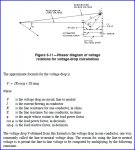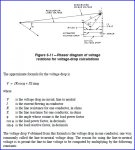I've looked at several other threads and websites where this NEC Table 9 Note 2 formula is discussed, and I'm still slightly confused.
When using the Effective Z from the table (for 0.85 power factor) -- or when calculating a new Effective Z (for some other power factor) -- in order to calculate voltage drop on a line, do we use only the magnitude of the current, and disregard the phase angle? More fundamentally, I don't understand why we use the concept of "effective Z" rather than using the actual impedance (R + j X -- notice the j) given in Table 9 along with proper vector math (that is, using " j " in the value of the line impedance X_L).
To clarify: let's assume #1/0 uncoated copper in PVC, 1000' from source to load, with I = 50 ∟-49.5 A (that is, PF = 0.65 lag, and assuming source voltage angle = 0). For this cable, R = 0.12 Ω and X_L = j 0.044 Ω, per Table 9. The voltage values below are drop from source to load, (not the full single-circuit roundtrip, which requires multiplying by 2).
Am I missing something? Why is the answer in (A) much different from those in (B) and (C)?
I'm preparing for the PE exam next week and this is one thing I've never fully understood, since various practice problems seem to solve it using any of the three ways stated above. I suppose I don't really understand the concept of "Effective" impedance and why using actual impedance - along with current and voltage phase angles - isn't correct.
When using the Effective Z from the table (for 0.85 power factor) -- or when calculating a new Effective Z (for some other power factor) -- in order to calculate voltage drop on a line, do we use only the magnitude of the current, and disregard the phase angle? More fundamentally, I don't understand why we use the concept of "effective Z" rather than using the actual impedance (R + j X -- notice the j) given in Table 9 along with proper vector math (that is, using " j " in the value of the line impedance X_L).
To clarify: let's assume #1/0 uncoated copper in PVC, 1000' from source to load, with I = 50 ∟-49.5 A (that is, PF = 0.65 lag, and assuming source voltage angle = 0). For this cable, R = 0.12 Ω and X_L = j 0.044 Ω, per Table 9. The voltage values below are drop from source to load, (not the full single-circuit roundtrip, which requires multiplying by 2).
A) Using the normal method with complex numbers, V=IZ = I(R+jX) (that is, with j on the reactance): (50 ∟-49.5 A) (0.12 + j 0.044 Ω) = 6.39 ∟-29.4 V
B) Using the NEC (IEEE Red Book) method with the Current phase angle: (50 ∟-49.5 A) [ 0.12 cos(-49.5) + 0.044 sin(-49.5) Ω ] = 2.22 ∟-49.5 V
C) Using the NEC (IEEE Red Book) method with only the Current magnitude: (50 A) [ 0.12 cos(-49.5) + 0.044 sin(-49.5) ] = 2.22 ∟0 V
Am I missing something? Why is the answer in (A) much different from those in (B) and (C)?
I'm preparing for the PE exam next week and this is one thing I've never fully understood, since various practice problems seem to solve it using any of the three ways stated above. I suppose I don't really understand the concept of "Effective" impedance and why using actual impedance - along with current and voltage phase angles - isn't correct.
Last edited:




